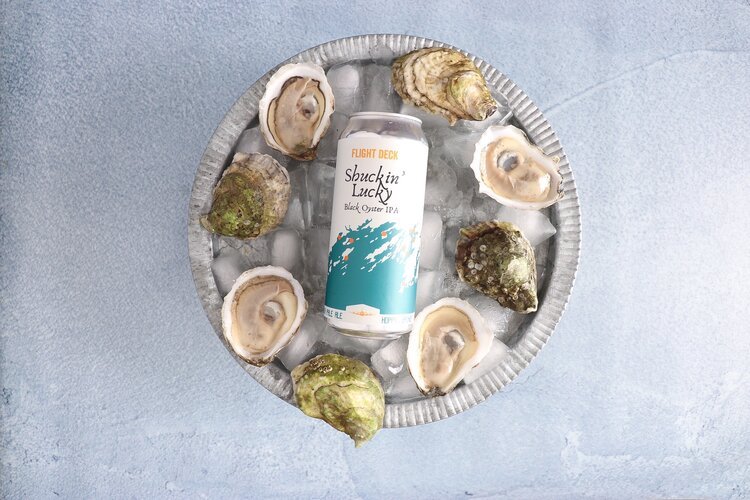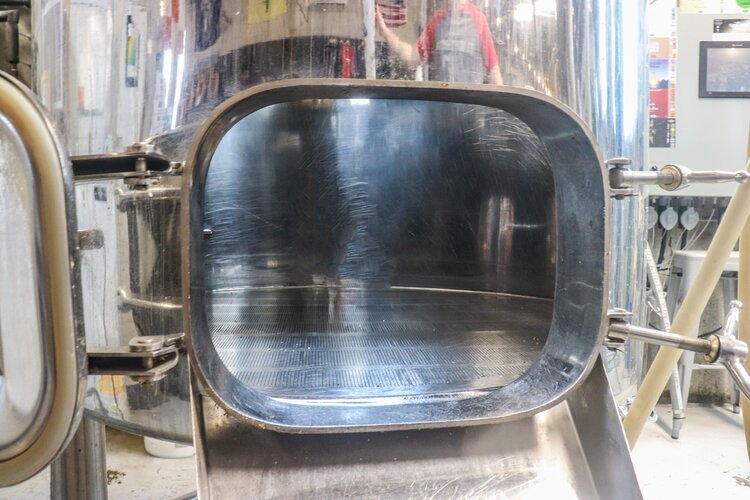Shuckin’ Lucky from Flight Deck Brewing
Shuckin' Lucky: Crafting a Black Oyster IPA with Flight Deck Brewing
Oysters belong in your beer. Yes, I know, the statement sounds perplexing. We live in a culinary world where freshly shucked bivalves grace the top of Bloody Marys, and excess oyster liquor is added to a martini to amplify the brine. But there are delicious, sustainable, and scientific reasons why New England craft breweries are adding oysters to their brews.
“Oyster beers” aren’t a new concept—the style of beer has been around for over one hundred years, and is recognized by the Beer Judge Certification Program (BJCP) as a sub-category within the “sweet stout” section of the dark British beers. Most breweries undertaking crafting an “oyster beer” stick with creating a stout, with a semi-sweet flavor brewed with actual oyster shells.
Recently, however, an increasing number of breweries are venturing away from stouts, and instead utilizing oyster shells to brew other styles of beer. Enter: Flight Deck Brewing’s Shuckin’ Lucky, a Black Oyster IPA, a Maine brewery’s inventive spin on a historical style of brewing utilizing oyster shells from nearby oyster farms.
***
Truthfully, I was a bit hesitant to take my first sip of Shuckin’ Lucky – a Black Oyster IPA born from the exclusive collaboration between Flight Deck Brewing in Brunswick, Maine, and Portland’s Maine Oyster Company. I remember popping the tab of the beer, and clasping my eyes shut as I pressed my lips to the lid, worried that I would taste a discordant concoction of hops and oyster liquor. But I was amazed when I sipped a balanced blend of citrus, pine, and touch of roasted sweetness with a faint trace of brine. In fact, the hint of brine tasted just like adding a sprinkle of sea salt to a scrumptious piece of chocolate.
A couple of weeks following my first sample of Shuckin’ Lucky, I set up a meeting with Ben Rossignol, Head Brewmaster, and Justin Simpson, Director of Wholesale and Distribution, of Flight Deck Brewing. I was determined to learn from the masters themselves how oysters could be re-purposed beyond a raw bar.
Flight Deck Brewing: A Tribute to Beer and Maine’s Naval History
I met Ben and Justin at Flight Deck on a rainy Friday morning. Despite the weather, I was immediately awestruck by Flight Deck’s space. Beautiful floor-to-ceiling windows adorned the length of the tasting room, allowing for light to permeate the space and warm the walls, which were embellished with a combination of one-part brewing gear, and one-part memorabilia commemorating the space’s naval origins.
Flight Deck was founded in early 2017 in the former Small Arms Range of the Brunswick Naval Air Station. The Station has a fascinating history dating back to its construction in 1943. The original mission of the NAS Brunswick was to train and form up the Royal Navy Fleet pilots to fly squadrons for the British Naval Command in World War II. The site was an important naval station throughout the 20th century, until it was decommissioned in 2011. It was then transformed into Flight Deck’s brewery and tasting room.
As I slowly walked the length of the tasting room, eyes scanning the homages to beer and flight alike, Ben approached me with a warm handshake and a glass of Flight Deck’s Shuckin’ Lucky. After all, you can’t write about the product without doing your fair share of taste tests.
Ben is a self-taught brewing expert and native of Maine. After mastering the art of home brewing, Ben volunteered on the bottling assembly line at Night Shift Brewing in Everett, Massachusetts. With his foot in the door of the brewing world, Ben went on to work his way up to brewing positions at both Hopsters Brewing Company and Boston Beer Works. He returned to his native Maine when he took a position as the head brewmaster at Boothbay Craft Brewery, before being recruited to Flight Deck.
The History of Oyster Beers
So, how did beer enthusiasts first come up with the concept of adding bivalve shells to beer? The history is somewhat obscure, and there are two predominant theories as to how oyster beers were first created. Theory One is that in the 1920s, brewers discovered that by adding oyster liquor (the oyster juice) to batches of brew, this improved the beer’s head retention quality.[1] Theory Two is that oysters are a type of fining agent, which improves the clarity of beer. Historically, brewers used to add isinglass—the buoyancy bladder of tropical fish—in the brewing process because its high collagen level was a clarifying agent that produced a “brighter” beer.[2] It is thought that oyster shells, rich in calcium carbonate, improves the clarity of the beer. Whatever the origin, brew masters all agree that the brine and earthiness from the oyster shells highlight the sweetness of the beer.
The Origins of Shuckin’ Lucky
Ben got the idea for creating his very own oyster beer when he was at an outing with his Flight Deck team at Maine Oyster Company, a raw bar located in Portland, Maine. There, Ben chatted with some of the oyster farmers from Mere Point Oyster Company, and got introductory lectures on the life cycle of the oyster, and various oyster shell restoration projects.
Inspired by his experience at Maine Oyster Company, and after witnessing the camaraderie that existed in the aquaculture industry, he asked Maine Oyster Company owner, John Herrigel, if he could have a batch of oyster shells.
The next week, John personally delivered over 25 pounds of oyster shells from oysters grown throughout Maine – from the waters of Casco Bay to the fabled tides of the Damariscotta. Shuckin’ Lucky, the eventual collaborative creation, features the conglomeration of shells from over 10 different oyster farms in Maine.
Ben explained that he was interested in creating an oyster brew not just to add to Flight Deck’s menu, but also to find uses for oyster shells instead of allowing them to simply be discarded. This commitment to sustainability not only exists in the aquaculture world, but also in Flight Deck’s business mission. Flight Deck donates all of its mash (essentially, the leftover milled grains used in the brewing process) to Jim Cornish of the Stone Soup Institute, a farm and homestead that provides vocational training to those interested in Agrarian Studies. Ben was interested in recycling oyster shells into a tasty alternative to simply allowing them to be discarded.
The Black Oyster IPA: A Deliciously Non-Traditional Choice
Shells in hand, Ben was left deciding exactly what kind of beer he wanted to create. Ben explained that when oyster shells are used in brewing, they are typically used in the production of stouts. However, Ben admitted that in the brewery world, stouts do not traditionally sell as well as other types of beer. The most popular style of beer, Ben explained, was the IPA. The one issue with incorporating oyster shells into a traditional IPA, however, was the risk that the abundance of hops and bitterness in a traditional IPA would overpower any flavor the oyster shells might impart.
Instead, Ben decided to brew a Black IPA, which differs from a traditional IPA in two key ways. First, Black IPAs use two types of malts: roasted malts and caramel malts. These malts provide less intense bitterness when compared with a traditional IPA, and impart the beer with added coffee and caramel notes. Second, Black IPAs are dry-hopped, meaning hops are added during both the boiling and fermentation processes, as opposed to traditional IPAs that incorporate hops at the boiling phase but not the fermentation phase. Thus, Black IPAs are less bitter and a bit sweeter than traditional IPAs, but still retain the hoppiness that is beloved to the IPA style.
From Shell to Glass: The Shuckin’ Lucky Brewing Process
From shell to glass, Shuckin’ Lucky is a three week brewing process. The oyster shells are added early on, during the Mash stage, where the shells are combined with the milled malts and brewed for approximately six hours before the fermentation process begins. Ben was kind enough to give me a step-by-step tour as to how he brews Shuckin’ Lucky.
Step 1: The Malts: Ben begins his batch of Shucking Lucky with two types of malts—a caramel malt and a roasted malt. During the kilning process (where malt seeds that have begun to sprout are dried[3]) the sugars in the caramel malts crystallize, producing a hint of sweetness. Ben combines his base caramel malt with a roast malt, which has a slightly charred, coffee-like taste.
Step Two: Milling the Malts: Once the malts are selected, Ben mills—or crushes—them, in-house. The goal of milling the malts is to break-up the malts, while leaving some of their enzyme-containing husks intact which will aid in the brewing process.
Step 3: The Mash: The milled malts are then moved to Flight Deck’s Mash Tun where they are steeped in boiling water. During this process, the oyster shells are added. During the mashing process, the sugars, color, and flavors are extracted from the grain. When boiling water is added to the malts, the heat activates the malt’s enzymes, and they begin to “chew on” the sugars, fermenting them. Similarly, the boiling water also extracts the calcium carbonate, brine, and salinity from the oyster shells.
Step 4: Vorlauf: Vorlauf is German for “recirculation.” This step occurs near the end of the mash process, when the hot water has begun to infuse with some of the malts and oyster shells, producing the early version of beer, known as “wort.” At this stage, the wort is cloudy, and still contains particles of grain and shell. During the Vorlauf sequence, wort is drained from the mash tun and is recirculated over solid malt and oyster shell mash over and over again until the wort begins to look clear
Step 5: Lautering: Lautering is the step in which the wort (which has become increasingly clear) is separated from the residual mixture of solid malts and oyster shells. When making beers not containing pieces of shell, Flight Deck donates the remaining malts to a local farm to serve as animal feed. Once the wort is separated from the solid malts and shells, it is transferred to a vessel known as “the kettle” for the next step: boiling.
Step 6: Boiling: Once all the wort is in the kettle, the wort is boiled for 60-90 minutes. This ensures that the wort is sterile. Boiling also evaporates some liquid, concentrating the wort and intensifying the color somewhat. As the wort boils, Ben adds Chinook and Cascade hops at the start of the boil, to add bitterness, and also at the end of the boil, to intensify the aroma and flavor. During this stage, Ben also introduces some Irish Moss seaweed to act as a coagulant between the wort and the hops.
Step 7: Chilling: Once the hops have been added, mixed, and boiled, the wort is given time to rest and cool to approximately 68 ° F.
Step 8: Fermentation: Ben moves the chilled wort to a fermentation vessel (FV), where it will remain for the next three weeks. He adds an American ale yeast to the wort mixture. During this phase, the yeast eats the sugars produced during the boiling process and excretes alcohol and carbon dioxide. Throughout the fermentation process, Ben uses a hydrometer to check the density of the liquid to determine the rate of alcohol volume.
Step 9: The Final Hops: After 3 weeks in the FV, Ben adds in additional hops to the mixture. Shuckin’ Lucky is then ready to be packaged into cans and kegs.
Diehard IPA Fans: Stick with Black IPAs for Your Oyster Pairing
Shuckin’ Lucky is actually one of the first IPAs I have ever paired with an oyster and found it to complement, and not mask, the brine of the oyster. A couple months ago, I was determined to do a “beer and oyster taste test” to determine which beer paired best with my oysters. The most obvious finding in my experiment: traditional IPAs absolutely overpower your oyster. Any brine or sweetness to the oyster is lost to the strength of the IPA hops and bitterness. Stouts traditionally pair well with oysters because the malty and sweet notes actually enunciate the salinity and brine.
Because Black IPAs use roasted and caramel malts, this provides the beer with a hint of sweetness reminiscent of a stout, while retaining the earthiness and citrus flavors of a traditional IPA. This sweet yet earthy combination, without an abundance of bitterness, pairs exceptionally well with an oyster. The flavor profile does not overpower that of the oyster, and the complex flavor profile actually highlights the similarly diverse flavor profile of an East Coast oyster.























